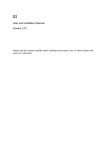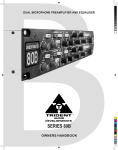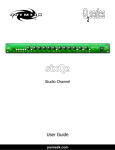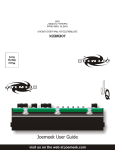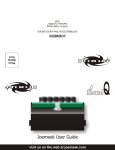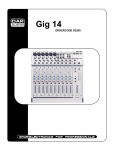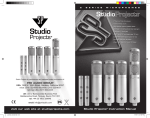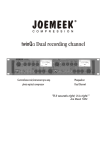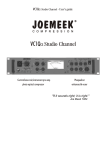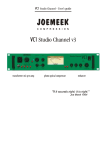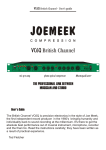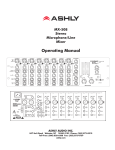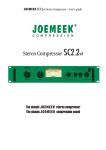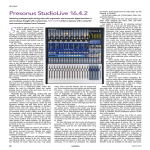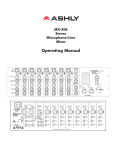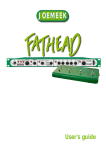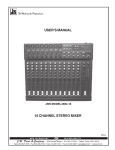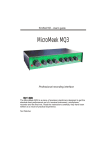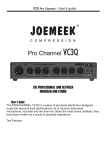Download manual
Transcript
three q manual.indd 1 4/8/05, 9:46 AM visit us on the web at joemeek.com Q THREE Joemeek User Guide JOEMEEK DISTRIBUTED BY PMI AUDIO GROUP 1845 W. 169th Street Gardena, CA 90247 USA Place Stamp Here 4/8/05, 9:46 AM 2-3 three q manual.indd three q manual.indd 4-5 4/8/05, 9:46 AM 3 3 Technical Specification...................................................15 Troubleshooting..............................................................14 Using the threeQ..............................................................12 Getting Connected.............................................................12 Using the Preamp...............................................................12 Using the Compressor.......................................................13 Using the Meequalizer.......................................................13 Overview............................................................................6 Preamplifier........................................................................6 Insert Point..........................................................................7 Compressor.......................................................................8 Meequalizer.......................................................................10 Mix Input.............................................................................11 Output Stage.....................................................................11 threeQ Controls at a Glance..............................................5 Contents The Next Generation of Joemeek has been completely re-engineered by renowned audio electronics consultant Allan Bradford. With his background in physics and 30 years experience with the design of instruments, mixers, processors and amplifiers, Allan’s unique range of expertise ensures that Joemeek remains at the forefront of music technology. About the Designer The Joemeek range provides everything you need to get your performance onto tape/disc. Properly and robustly engineered for predictable, controllable performance, the new range retains the famous Joemeek sound, with its wide, flat frequency response extending from subsonic to ultrasonic. It also uses genuinely low noise circuitry, with lots of headroom (immunity to overload). Accurate calibration and metering, together with clear panel labelling, give you complete confidence in what’s going on. While some equipment pays lip-service to quality and “professional rules” but fails to deliver, the Next Generation of Joemeek products are founded on good solid electronic and audio engineering, and withstand direct comparison with the very best names in mixers and outboard gear. The Next Generation of Joemeek studio processors represents a quantum leap in the history of the Joemeek legend. Long regarded for its “Big Sound”, the original Joemeek gear was both revered and reviled for its somewhat “quirky” nature. Now we have taken the best of what made the Joemeek products sound great, refined it, distilled it, added to it and repackaged it. JOEMEEK reborn – the legend grows Written by Allan Bradford, MSc UK: P.O. Box 358 Torquay, Devon TQ2 5XS tel: +44 (0) 180 3215111 email: [email protected] PMI AUDIO GROUP USA: 1845 W. 169th Street Gardena, CA 90247 toll free: 877-563-6335 fax: 310-323-0950 email: [email protected] Joemeek is manufactured and marketed under the direction of: three q manual.indd 6-7 4/8/05, 9:46 AM 5 4 LF - controls the volume of Low Frequencies or “Bass” in the audio spectrum. 15dB of boost or cut is available around 80Hz. COMP switch - turns the compressor on. The LED lights when active. COMPRESSION METER - 4-Led bargraph indicates the amount of gain reduction in dB, which is taking place at any given moment. RELEASE - sets the time during which the signal returns to its normal size after compression. In general, the longer the time, the less obvious the compression. ATTACK - sets how quickly the compressor responds to peaks above threshold. COMPRESS - sets the level of signal (or “Threshold”) above which the signal starts to be compressed. +4dBu/-10dBv switch - selects the output operating level of the threeQ, either to the professional +4dBu level, or to the -10dBv semi pro level. 48V PHANTOM POWER switch - when pressed in, feeds 48V phantom power to the microphone XLR connector. Most condenser type microphones require phantom power to operate. VU METER - 8-Led bargraph shows the output signal level in dB at any given moment. OUTPUT GAIN - is the volume control or “Fader” for the outputs of the threeQ. EQ switch - turns the equalizer on. The LED lights when active. HF - controls the volume of the High Frequencies or “Treble” in the audio spectrum. 15dB of boost or cut is available around 12KHz. MID FREQ - sets the frequency at which the MID control operates, anywhere from 300Hz to 5kHz. PEAK LED - lights 6dB below clipping. LINE switch - selects the Line (jack) input instead of the Mic (XLR) input. The LED lights when active. MID - controls the middle frequencies in the audio spectrum. 15dB of boost or cut is available at the selected frequency. PREAMP GAIN - sets the amount of audio amplification. Too little gain and the sound will be too quiet; too much and the signal could become distorted. threeQ Controls at a Glance three q manual.indd 8-9 4/8/05, 9:46 AM 7 6 The The The The Preamplifier JOEMEEK Optical Compressor Meequalizer Fader Of course when there is no signal going on, you may hear the background noise of the electronics. In that case, given the amount of gain in the studio monitoring system, this noise “floor” should ideally be in the region of -80dBu or lower, in order for it not to be noticed. So how do you achieve that in practice? The trick is to keep the microphone as close to the sound source as possible without overloading it, so as to get as much signal out of it as possible. Then you set the Gain control to give only as much gain as is needed to get a decent level into the recorder. TECHNICAL STUFF Very low noise - does it matter? Yes and no, it all depends what you are doing - what really matters is “signal-to-noise ratio”. All electronics produce a certain amount of background noise - it’s in the nature of things. Providing there is only a relatively small amount of noise, the signal will cover it up, or “mask” it. So providing the signal is much bigger than the noise, you won’t be aware of the noise. So in other words the “signal-to-noise ratio” needs to be a big number, ideally such as 80dB or 90dB. The PEAK LED lights 6dB below clipping, so occasional brief flashes are OK but if it’s on all the time you need to back the Input Gain off! There is just one other control, labelled “Input Gain”, which covers a range of amplification from 10dB to 60dB. In many other preamps the action of the Gain control is rather uneven, with the 40dB to 60dB range being crammed into the last 1/6th of a turn. All Joemeek preamps use a specially designed control that ensures smooth operation over the whole range of rotation. The (0) symbol next to the 25dB mark, means unity gain, or 0dB, for a signal in the Line input. Hence for Line inputs the range of gain adjustment either side of this mark, is +35dB, -15dB. When using dynamic or ribbon mics, do not turn this on. It probably won’t do any harm but it certainly won’t do any good, so leave it off! Consult the microphone handbook if you are unsure what kind of mic you have. This is the all-important front end to the threeQ. Its job is to accept any type of microphone, instrument or other source of audio signal, and make it loud enough; microphones often need rather a lot of amplification, while guitars, keyboards and CD players need less. Mics need to be connected to low impedance inputs, while instruments prefer high impedance inputs. To ensure correct impedance matching, the inputs are split into an XLR connector for Mics, and a jack “Line” connector for everything else. A switch on the front panel decides which input connector is active. The LED underneath the switch lights to show that the Line input (jack) is selected. Preamplifier • • • • Think of the threeQ as four separate items of equipment: The JOEMEEK threeQ is like having one channel of a professional recording studio in a small box. It takes a microphone or instrument, amplifies it, compresses and equalizes it ready to be recorded. Simple to use yet extremely powerful, the threeQ will bring out the best in any microphone or instrument and give the gloss of a professional studio production to all your performances. As well as recording it will also be found useful for live work. Overview When no jack is inserted, the socket is internally linked, or “normalled”, so that the signal flows uninterrupted. Note that the Insert Point is after the Preamp but before the Compressor and EQ. Tip: send Ring: return Sleeve: ground This is simply an unbalanced “Send and Return” jack on the rear panel. It allows you to patch any other pieces of equipment into the signal path, such as an effects processor or noise gate. To use it you will need a “Y” lead wired as follows: Insert Point The maximum gain available from the preamp is 60dB, in which case the noise floor will be -68dBu. This is actually quite noisy - if you record that noise onto a digital recorder and play it back you can definitely hear it. In practice of course, you do not record and play back “silence” and the rest of the mix will probably be more than 70dB louder than this noise and will mask it completely. Even so it is generally a good idea not to use gains greater than 40dB or 50dB and indeed, it should rarely be necessary to do so. The threeQ microphone preamplifier uses state-of-the-art electronics and has an equivalent input noise of around -128dBu (with 150ohm input load). Despite all the hyperbolae and obfuscation, the theoretical best possible performance for silicon-based electronics is about -132dBu. So the preamplifier design used in the threeQ and all other NextGen Joemeek products approaches this limit. To improve significantly on this would require highly specialised electronics and probably a vat of liquid Nitrogen to cool it! PHANTOM POWER Most high-quality studio mics are “Phantom powered”, which is to say they have electronics inside them, which get their power from the preamp. Most mics require a supply of 48 Volts, so Phantom Power is often labelled “48V”. There is a switch on the back of the threeQ (next to the XLR mic connector) to turn this power on or off. A red LED lights when this power is on. When switching the Phantom Power on, quite a loud thump may be produced, so it is a good idea to turn down the Output Gain (or to momentarily select the Line input), when pressing the switch. The Mic Input (XLR) is balanced and wired as follows: Pin 2: + (hot) Pin 3: - (cold) Pin 1: ground The Line Input (jack) is balanced and wired as follows: Tip: + (hot) Ring: - (cold) Sleeve: ground Both Mic and Line inputs are electronically balanced. Note: although the Line input is not normally used for microphones, it can be suitable for some high output unbalanced microphones, such as battery powered Electret types. Switch out (LED off) = “Mic” Switch in (LED on) = “Line” In other words: three q manual.indd 10-11 4/8/05, 9:46 AM 9 8 Controls ‘COMPRESS’ sets the level of signal (the “Threshold”) above which the signal starts to be compressed. Turning the COMPRESS control clockwise lowers the compression threshold, and drives the compressor harder. Variable Ratio In the Joemeek optical compressor the compression ‘threshold’ is not clearly defined and the compression ratio varies with the amount of compression applied. For signals only just exceeding threshold, the ratio is little more than 1:1. As the compressor is driven harder, the ratio rises to 5:1, at least up to a point. It is a feature of the Joemeek compressor that the compression ratio actually reduces again during large transients and, adjusted correctly, this helps to retain brightness that is often lost with other types of compressor. This is why vintage compressors often sound more lively than their modern counterparts. Some compressors have a control to set the ratio anywhere between 1:1 (ie: no compression), and 20:1 (which would be regarded as a “brick wall limiter”). In the threeQ the “Slope” or “Compression Ratio” is fixed at 5:1. This is a good compromise between being gentle enough for vocals and hard enough for drums and guitars. However that’s not all there is to it. Compression Ratio What?? OK, it’s simpler than it sounds. If the input gets 10dB louder but the output only increases by 5dB then the compression ratio is “2 to 1”. If the input goes up 10dB but the output only goes up 1dB, then the compression ratio is “10 to 1”. In a theoretically ideal compressor, this ratio is the same for any size of signal above the threshold but for that to be true, the gain cell and its control circuitry must be perfectly linear over a very wide range. In practice only compressors based on VCAs and digital potentiometers are likely to behave in this way. 3. Protection Fast response times are generally used to control brief transients. In other words if an occasional peak sticks its head above a maximum permitted level, the compressor clobbers it; this is known as limiting and a compressor designed solely for this purpose is known as a Limiter. Limiters are primarily used to protect recorders and monitor systems from overload, radio transmitters from overmodulation, etc. The Joemeek compressor is not primarily intended for this purpose as the Attack is not really fast enough to satisfy 2. Crank Up The Volume Raising the average volume of whole mixes means they can be heard in noisy environments, such as vehicles and factories. Boosting the average level is what makes radio stations sound LOUD and the same technique is used on TV commercials too, which is why they always seem annoyingly louder than the movie you were trying to watch! 1. Make Sounds Stand Out Because compressors make loud sounds quieter, you can boost the volume of the quiet bits without the loud bits getting even louder. That means you can raise the average level of an instrument or vocal in the mix, which has the effect of lifting it and bringing it forwards. This can actually improve vocals for example, bringing them out in front of a mix, making them sound denser, more even, and more confident! The hardest device to understand, yet one of the most useful, the PhotoOptical Compressor is what gives Joemeek products their unique character. Its job is to make quiet sounds louder and loud sounds quieter, or in other words to reduce the dynamic range of the programme material. It’s a bit like manually riding the volume control, except the compressor does it automatically, responding far quicker and more accurately than you ever could by hand. The compressor is applied in several ways: Compressor The Compressor is after the Preamplifier and the Insert Point, and before the Meequalizer. How the compressor behaves actually changes with programme content and volume. So experiment with the controls with different kinds of material to discover the range and depth of effects that can be achieved. The “COMP” in/out switch allows comparison between compressed and uncompressed sound (green LED lights when active). ‘RELEASE’ sets how long the compressor goes on squashing the sound for, once the signal has dropped below threshold. If it stopped instantly there would be very noticeable modulation or “pumping” of the sound. So we want it to stop compressing less abruptly and that is what the Release control is for. Generally, the longer the Release time, the less obvious is the compression. Of course some “pumping” might actually be desirable as a special effect and that is another way in which the envelope of a sound can be modified. The threeQ Release is variable from 100mS up to 3 seconds giving a wide variety of effects. ‘ATTACK’ sets how quickly the compressor reacts to peaks above threshold. Turn this control anti-clockwise for a quick response. Slower (clockwise) allows the fast leading edge of percussive sounds to pass uncompressed for a moment, before the compressor reacts to control the gain. This example of “changing the envelope” of a sound exaggerates the percussive nature of drums and other instruments. Faster attack times (anti-clockwise) are used where the compression needs to be less obvious. For vocals the Attack needs to be around 10msec for a natural sounding result. The threeQ Compressor is a unique recreation of the sort of photoelectric compressor used by record producer Joe Meek in the 1960’s. Using modern components for consistency and reliability, it nonetheless reproduces faithfully the same punchy sound that was so characteristic of the pop records of that time. Types of Compressor Most compressors work in essentially the same way: a volume-controlling element or “gain cell” is inserted into the audio signal path. The level of the signal at any given moment is measured and that information is used to control the gain cell. So if the signal gets bigger, the volume is turned down. Various types of gain cell in common use include FETs, valves (tubes), light-dependent-resistors (photoelectric), digital potentiometers and voltage-controlled-amplifiers, better known as VCAs. 5. Modification A compressor can change the dynamics, or “envelope” of the track and it is here that the Joemeek Compressor excels! 4. Accommodation The dynamic range of the human ear is phenomenal, extending from the threshold of hearing (eg: a pin dropping onto soft carpet) to threshold of pain (eg: standing next to a jet aircraft) - some 120dBA in all. By contrast, vinyl, cassette tape and radio broadcasts all have a dynamic range of about half that. Since the advent of the CD, the dynamic range of the medium is far less of an issue and compressors are used more to give a certain “feel” to a production. AM and FM radio however, is still very much compressed to fit its restricted dynamic range. radio station requirements, although it is generally good enough to protect recorders and monitors, where the effect of transients is less critical. Normally you should not hear a limiter operating but if it is driven hard constantly, it can render a mix somewhat flat and lifeless. three q manual.indd 12-13 4/8/05, 9:46 AM 11 10 OUTPUT GAIN This output volume control provides up to 16dB of gain, which may be useful when a lot of compression is going on. It also goes right down to nothing and so acts as a fader to fade a sound out completely. Output Stage Another application is in a simple live performance setup. For example one threeQ could process a vocal while a second processed a guitar. The two signals would then be mixed before feeding a PA slave amplifier. Perhaps a drum machine would also be added in to the spare Mix input on the first threeQ. Voila! A complete performance mix without a mixer. In fact three or more threeQ’s could be “daisy-chained” in this way, by connecting the output of the first to the Mix input of the second and so on. The Output Gain control on the last threeQ in the chain provides the overall volume for the PA. The Mix Input is balanced and wired as follows: Tip: + (hot) Ring: - (cold) Sleeve: ground This is a jack on the rear panel, which allows you to connect a second audio source (for example another Joemeek threeQ!) The Mix input comes after the threeQ’s Preamp, Compressor and Meequalizer, but before the Output Gain control. So the second source is not affected by any of the threeQ’s signal processing but is mixed with the material which has been processed by the threeQ. The usual application for this is in overdubbing in simple recording setups. Mix Input The Meequalizer is after the Preamplifier, the Insert Point and the Compressor. The Mid band can be tuned or “swept” anywhere between 300Hz and 5kHz (at either end it will also have some effect on frequencies below 300Hz or above 5kHz). This effectively covers the whole of the important range of mid frequencies. It may help to think of it as like a graphic equalizer, only instead of lots of frequency bands, you have just one, but it can be moved to cover any given frequency band. Cutting the Mid can reduce sibilance, boominess or other annoying resonances. Boosting can bring out the body of a vocal, or the harmonics of a guitar or any other instrument. Increasing or reducing the “presence” of an instrument or vocal in this way, can appear to move the sound forwards or backwards in a mix. The HF or treble section is centred at 12kHz and boosting this band gives a sense of “air” or “sparkle” to vocals, instruments and mixes, without boosting harsh upper-mid frequencies. Alternatively with bass instruments, cutting will reduce HF noise such as hiss and crackle. The LF or bass section is centred on 80Hz, the frequency most effective in bringing out bass lines and kick drums when boosted. Cutting can be used to reduce unwanted LF noise, such as hum or rumble. The threeQ “Meequalizer” is a highly effective and musically rewarding three-band equaliser, or tone control system. Each stage allows boost or cut of up to 15dB around the frequency in question. The “EQ” switch turns the equalizer on, and the green LED lights when active. Meequalizer Technical Stuff All outputs on all NextGen Joemeek products are properly balanced, which is to say there is a signal on both pins! In this way the maximum possible common-mode rejection of interference, can be achieved at the receiving end. Balanced or Unbalanced Here’s the clever part: to run unbalanced, just plug in a mono jack plug. This increases the gain of the “+” signal by 6dB, so there is no drop in level compared with balanced gear. Note that in the threeQ these two outputs are not isolated from each other, so unbalancing one will unbalance the other one as well. These outputs are balanced and wired as follows: Tip: + (hot) Ring: - (cold) Sleeve: ground CONNECTORS Two identical paralleled output jacks are provided, so you can simultaneously feed (say) a recorder and a monitor amplifier. The adjacent switch selects the output operating level to either +4dBu (suits most professional studio equipment) or -10dBv (suits semi-pro or hi-fi equipment). Check with the handbook for whatever you are feeding, to find out which level is required. VU METER The LED VU Meter shows signal level at the outputs, after the Output Gain fader. It covers the range -24dB to +12dB in eight steps. Note that this is relative to the selected operating level of “+4dBu” or “-10dBv”. In other words if you have selected “4dBu” and the meter reads “0”, then you have +4dBu coming out of the output sockets. If you have selected “-10dBv” and the meter reads “0”, then you have -10dBv coming out of the output sockets. Mid frequency response (at 300Hz and 5kHz) LF and HF frequency response Technical stuff Each section of the Meequalizer has a peaking or “bell” shaped frequency response, which will be found to be musically more satisfying than conventional “shelving” equalisers. The use of bell curves at LF and HF also avoids boosting subsonics and ultrasonics which can have adverse effects on other studio equipment, such as recorders, monitor amplifiers and speakers. The “Q” value of the peaking filters is 0.9 (or 1.6 octaves). Zero phase distortion ensures the best possible audio coherence. three q manual.indd 14-15 4/8/05, 9:46 AM 13 12 Always start with the Meequalizer boost/cut controls (LF, MID and HF) set to “0” (the control knobs set vertically, in their centre notches). This setting is also known as “flat”. Using the Meequalizer Use the ‘COMP’ switch to make comparisons between compressed and uncompressed signals. The overall result of compression depends on the combined settings of the Input and Output Gain, Compress, Attack and Release controls. Experiment with different combinations to discover what best suits the material you wish to compress. Watch the GR meter and don’t overdo things - it’s possible to apply 20dB of gain reduction before you realise it! Set ‘COMPRESSION’ and ‘ATTACK’ fully anti-clockwise and ‘RELEASE’ at mid-position. Press the ‘COMP’ push-button and turn up the ‘COMPRESSION’ control until the compressor GR meter starts to read 2dB or 4dB on audio peaks. You should now be able to hear the compressor working as the volume diminishes. Use the Output Gain control to restore the signal to its previous (uncompressed) level. Try slowing the Attack and listen for percussive sounds getting louder. Reducing the Release time should emphasise this even more and the compressor should start to “pump” audibly. Start with the Compressor and Meequalizer off and adjust the input and output gain so that the VU Meter reads around 0dB. Using the Compressor The figure shows the threeQ being used instead of a mixing desk in a recording setup GETTING CONNECTED Using the threeQ Experiment with combinations of settings of EQ and try to picture how the audio signal is being affected. Use the “EQ” switch to make comparisons between EQ’d and non-EQ’d signals. The way to use the MID FREQ is to apply quite a lot of boost, then sweep the frequency until you “tune in” to the sound you are interested in. Once you find it, adjust the amount of boost or cut to give the desired effect. Keep an eye on the VU Meter when adjusting the EQ. When the red LED (labeled “+12”) lights, the threeQ is within 4dB of clipping. This may therefore be regarded as a “Peak” or “overload” LED. Occasional flashes are OK but if it is on all the time, turn something down! You need to be careful about too much boost or “lift”, since boosting takes the threeQ closer to overload. The threeQ has generous overload margins, but when a lot of boost is used, it may be necessary to compensate by reducing the Output Gain or the Input Gain (the latter will affect the Compressor setting though). Turn the ‘INPUT GAIN’ control to minimum and connect the input source. If you are using a condenser microphone, remember to switch on the 48V Phantom Power. Set the ‘OUTPUT GAIN’ to “0dB”. Turn up the ‘INPUT GAIN’ until the microphone sound registers on the LED VU Meter, adjusting it so that the yellow “0” or “+4” LEDs light on sound peaks. When the red LED (labeled “+12”) lights, the threeQ is within 4dB of clipping. This may therefore be regarded as a “Peak” or “overload” LED. Occasional flashes are OK but if it is on all the time, turn the Input Gain down! Using the Preamp POWER SUPPLY Connect the threeQ Power Supply to the AC connector on the rear panel and switch on the mains supply. NB: Use only the 12V ac mains adaptor supplied. Use of any other power supply may damage the threeQ and will invalidate the warranty. • Previously recorded tracks may also be replayed via the Line Input, to permit compression and equalization • The recorder output is connected to the Mix Input for monitoring and overdubbing • The insert point is being used to divert the preamplified signal through an external effects processor • An additional source is being fed into the Line Input • A microphone is connected to the Mic Input three q manual.indd 16-17 4/8/05, 9:46 AM 15 14 Mic: 1.2kohm; Line: 20kohm 10dB to 60dB (variable) 70dB -128.5dBu (unweighted) 0.001% (below Compressor threshold) 15Hz to 70kHz (-3dB) Mic: +19.5dBu; Line: +44.5dBu +19.5dBu -6dBu to +20dBu (variable) 5:1 (typical) 1 msec to 100 msec (adaptive) 0.1 sec to 3 sec (adaptive) Input impedances Pre-amp overall gain Common mode rejection Equivalent input noise Distortion Frequency response Maximum input before clipping Headroom before clipping Compressor threshold Compressor ratio Compressor attack time Compressor release time Technical Specification • Is the ‘Comp’ switch in (LED on)? • Is the ‘Compress’ control turned up enough? • Is there enough signal, as set by the ‘Input Gain’ control, to drive the compressor? 4) The compressor doesn’t work 3) The line input doesn’t work • Is the source connected to the correct (jack) input on the back of the unit? • Is the ‘Line’ switch in (LED on)? • Is the ‘Input Gain’ control turned up? • Is the ‘Output Gain’ control turned up? 2) The microphone doesn’t work • Is it connected to the correct (XLR) input on the rear panel? • If it is a condenser microphone, is the phantom power switched on? • Is the ‘Line’ switch out (LED off)? • Is the ‘Input Gain’ control turned up? • Is the ‘Output Gain’ control turned up? 1) No Power (no lights work) • Is the power supply plugged in (both ends)? • Is the mains power on? Troubleshooting 80Hz 300Hz to 5kHz variable 12kHz +4dBu/-10dBv LF Frequency MID Frequency HF Frequency Nominal output levels 220W x 44H x 180D (overall) 1 kilo Weight 12W 12V ac mains adaptor 8 segment bargraph -85dBu (typical, with ~40dB mic gain) 12dB attenuation Mechanical Power consumption Power supply VU Meter Noise Floor Output Level switch 100 ohm 0.9 (1.6 octaves) EQ “Q” Output impedance +/-15dB (zero phase-shift bell response) EQ Boost and Cut 8) Sounds distorted • Is the ‘Input Gain’ control too high? • Is the ‘Output Gain’ control too high? • Is there too much EQ boost? • When using the compressor, is the Release control set too low? 7) Too much noise • Is the ‘Input Gain’ control too high? Try moving the mic closer to the source • Is the ‘Output Gain’ control too high (eg: when lots of compression is being used)? • Is there too much EQ boost? • Is the noise already present in the input signal? (Try removing the input) 6) The Meequalizer doesn’t work. • Is the ‘EQ’ switch in (LED on)? • Is ‘Input Gain’ control turned up? • Is ‘Output Gain’ control turned up? 5) Too little or too much compression • Turn the ‘Input Gain’ control up or down respectively, to adjust the signal level to the compressor three q manual.indd 18-19 4/8/05, 9:46 AM Joemeek Limited Warranty 1. Notification of claims: Warranty Service: If Purchaser discovers that the Product has proven defective in material or workmanship, then written notice with an explanation of the claim shall be given promptly by Purchaser to PMI but all claims for warranty service must be made within the warranty period. If after investigation PMI determines that the reported problem was not covered by the warranty, Purchaser shall pay PMI for the cost of investigating the problem at its then prevailing time-and-materials rate. No repair or Conditions B: In addition, PMI Audio Group will supply, at no charge, replacements for defective parts for a period of (three years) from the date of purchase. During the labor warranty period, to repair the Product, Purchaser must return the defective Product, freight prepaid, or deliver it to PMI Audio Group Service Center. The product to be repaired is to be returned in either its original carton or a similar package affording an equal degree of protection. PMI Audio Group will return the repaired Product freight prepaid to the Purchaser. PMI Audio Group is not obligated to provide Purchaser with a substitute unit during the warranty period or at any time. A: For a period of (3) three years from the date of purchase (hereinafter the labor warranty period), PMI Audio Group will repair or replace this Product if determined to be defective. After the expiration of the labor warranty period, the Purchaser must pay labor charges. PMI Audio Group warrants that all products will be free from defects in material or workmanship: THIS PRODUCT IS FOR PROFESSIONAL USE ONLY Notes 4. Proof of purchase: The dealer’s dated bill of sale must be retained as evidence or the date of purchase and to establish warranty eligibility 3. Exceptions to Limited warranty: PMI shall have no liability or obligation to Purchaser with respect to any Product subjected to abuse, improper use, negligence, accident, modification, failure of the end-user to follow the operating and maintenance procedures outlined in the users manual, attempted repair by non-qualified personnel, operation of the unit outside of the published environmental and electrical parameters, or if such products original identification (trademark, serial number) markings have been defaced, altered, or removed. PMI excludes from warranty coverage, Products sold AS IS and/or WITH ALL FAULTS and excludes used products which have not been sold by PMI to the Purchaser. PMI also excludes from warranty coverage consumables such as fuses and batteries, tubes, etc. 2. Exclusive Remedy: Acceptance: Purchaser’s exclusive remedy and PMI’s sole obligation is to supply (or pay for) all labor necessary to repair any product found to be defective within the warranty period and to supply, at no extra charge, new or rebuilt replacements for defective parts. If repair or replacement fails to remedy the defect, then and only in such an event, shall PMI exchange to Purchaser a new or reconditioned unit. Purchaser’s failure to make a claim as provided in paragraph 1 above or continued use of the product shall constitute an unqualified acceptance of such Product and a waiver by Purchaser of all claims thereto. replacement by Purchaser of any Product or part thereof shall extend the warranty period as to the entire Product. The specific warranty on the repaired part only shall be in effect for a period of ninety (90) days following the repair or replacement of that part or the remaining period of the Product warranty, whichever is greater. three q manual.indd 20-21 4/8/05, 9:46 AM Date Purchased: Dealer: Model Purchased: Serial Number: Zip Code: ❏ MIX ❏ Electronic Musician ❏ EQ ❏ Sound on Sound ❏ Pro Audio Review ❏ Recording ❏ Pro Sound News ❏ Audio MIDI What magazines do you read to influence your buying decision: (please check all that apply) email Address: Telephone Number: Product Registration Information Please Fill in the Below Sections and Return Specifications and model numbers are subject to change without notice P L E A S E D I S PAT C H A N D R E T U R N Y O U R R E G I S T R AT I O N T O J O E M E E K W I T H I N 1 4 D AY S OF PURCHASE R E TA I N F O R Y O U R R E C O R D S Dealer’s Name ______________________________________ Serial Number ______________________________________ Date of Purchase ____________________________________ Name _____________________________________________ State: Comments: Owners Registration Card T O B E C O M P L E T E D AT T I M E O F P U R C H A S E City: Address: Name: Copyright © 2005 PMI Audio Group. All rights reserved. PMI, PMI AUDIO, TED FLETCHER, MEEQUALIZER, STUDIO PROJECTS, JOEMEEK, TOFT AUDIO DESIGNS, CURRENTSENSE, MEEKROPHONE, TRAKPAK, and (If it Sounds Right...It is Right!) are either registered trademarks or trademarks of PMI Audio Group in the U.S.A. and/or other countries. PMI Audio Group may have trademarks, copyrights or other intellectual property rights covering the subject matter of this User Guide. Except as expressly provided in any written agreement from PMI Audio Group, the furnishing of this User Guide is provided for the sole use of the authorized User [or Service Agent where applicable] and does not give the User any license to use any trademarks, copyrights or other intellectual property of PMI Audio Group. Information in this User Guide is subject to change without notice. No part of this User Guide may be reproduced or transmitted in any form or by any means, electronic, mechanical or by any other means, for any purpose, without the express written permission of PMI Audio Group. LOSS OF PRESENT OR PROSPECTIVE PROFITS OR ANY OTHER REASON WHATSOEVER. NOT LIMITED TO, COMPENSATION, REIMBURSEMENT OR DAMAGES ON ACCOUNT OF THE INDIRECT, INCIDENTAL, OR CONSEQUENTIAL DAMAGES OF ANY KIND INCLUDING, BUT CLAIM IS MADE. IN NO EVENT SHALL PMI BE LIABLE TO PURCHASER FOR ANY SPECIAL, THAN THE ACTUAL PURCHASE PRICE OF THE PRODUCT WITH RESPECT TO WHICH SUCH THEORY AND WHETHER ARISING IN TORT OR CONTRACT, SHALL NOT BE GREATER DAMAGES FOR ANY CLAIM OF ANY KIND WHATSOEVER, REGARDLESS OF THE LEGAL THE LIABILITY OF PMI, IF ANY, AND PURCHASER’S SOLE AND EXCLUSIVE REMEDY FOR Limitation of Liability PURCHASER MAY CHOOSE TO CONNECT TO THE PRODUCT. THE PRODUCT IS COMPATIBLE WITH ANY COMBINATION OF NON-PMI AUDIO PRODUCTS STATE STATUE. PMI HEREBY DISCLAIMS ANY REPRESENTATIONS OR WARRANTY THAT IN SECTION 2-312(3) OF THE UNIFORM COMMERCIAL CODE AND/OR IN ANY COMPARABLE OR ANY WARRANTY WITH REGARD TO ANY CLAIM OF INFRINGEMENT THAT MAY BE PROVED IMPLIED WARRANTIES OF MERCHANT ABILITY, FITNESS FOR A PARTICULAR PURPOSE AND/ OTHER WARRANTIES, EXPRESS OR LIMITED, INCLUDING, BUT NOT LIMITED TO ANY/OR ALL EXCEPT FOR THE FORGOING WARRANTIES, PMI HEREBY DISCLAIMS AND EXCLUDES ALL Disclaimer of Warranty











